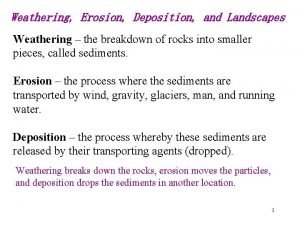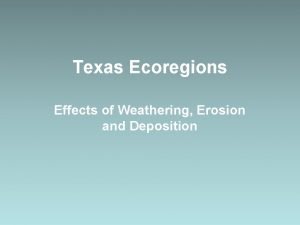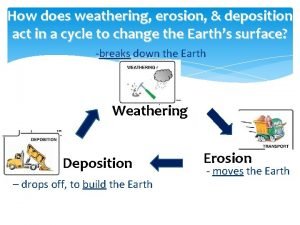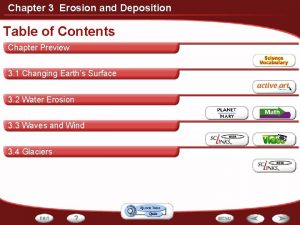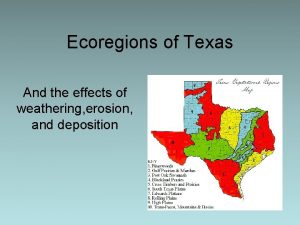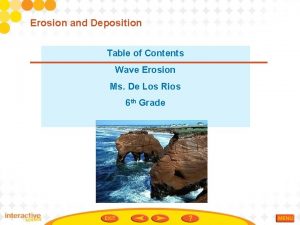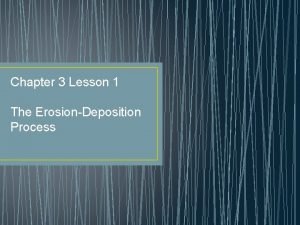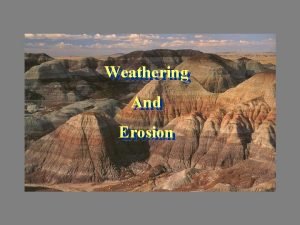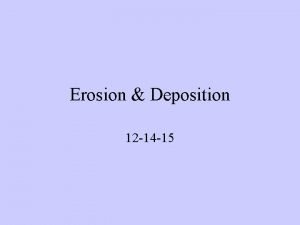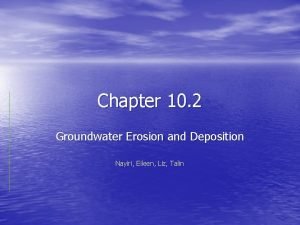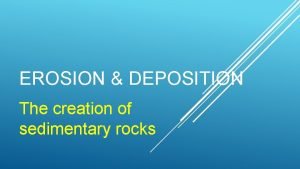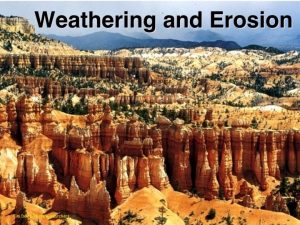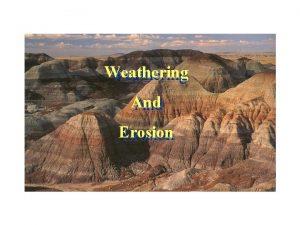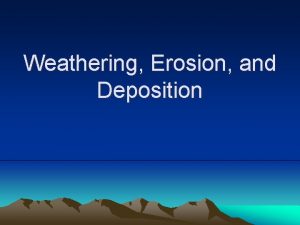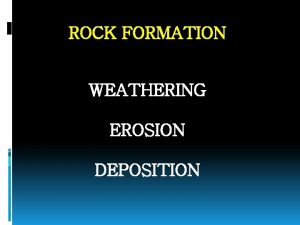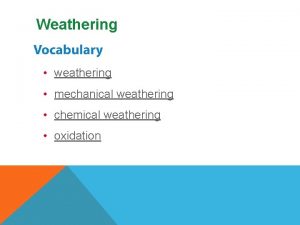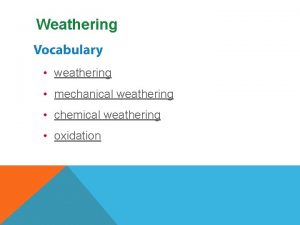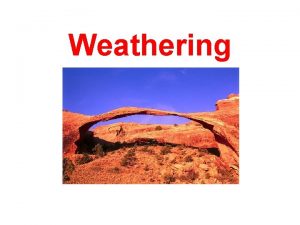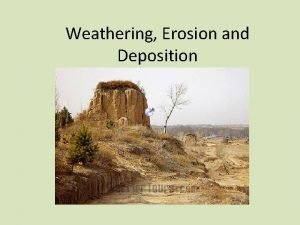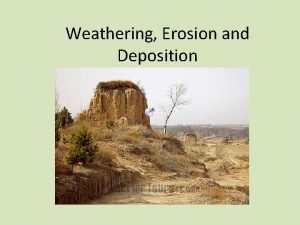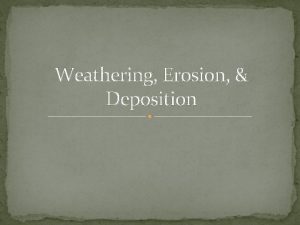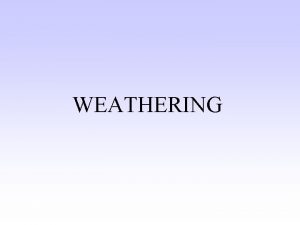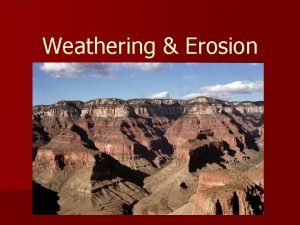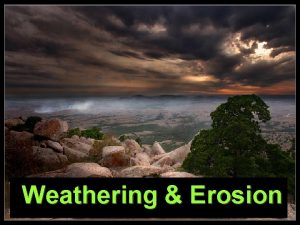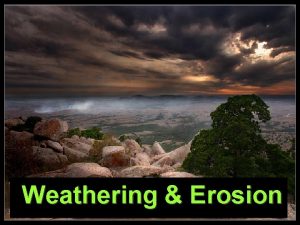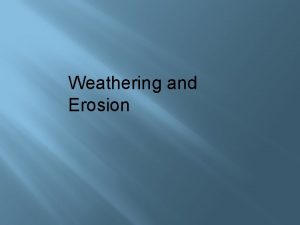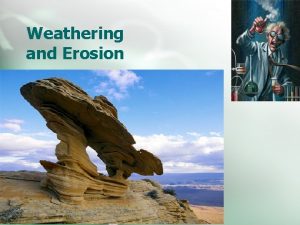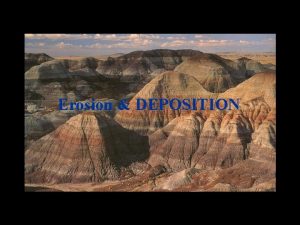ROCK CYCLE WEATHERING EROSION DEPOSITION HUMAN IMPACT SC


















- Slides: 18

ROCK CYCLE, WEATHERING, EROSION, DEPOSITION, & HUMAN IMPACT SC. 7. E. 6. 2 IDENTIFY THE PATTERNS WITHIN THE ROCK CYCLE AND RELATE THEM TO SURFACE EVENTS (WEATHERING AND EROSION) AND SUBSURFACE EVENTS (PLATE TECTONICS AND MOUNTAIN Essential Question: How does weathering, BUILDING). erosion and deposition shape the Earth and contribute to the rock cycle?

BELLRINGER Limestone caves can develop when limestone rock is weathered. The weathering of the rock leaves an empty space that forms the cave. Which of the following best explains how the limestone weathered? a) Animals burrowed through the limestone. b) Wind blowing across the surface eroded the limestone. c) Water flowing through the rock dissolved the limestone. d) Moss and plants grew on the rock and broke down the limestone.

I DO GUIDED NOTES

ROCK CYCLE: • The gradual series of events that causes rock to change into different forms: • Igneous • Sedimentary • Metamorphic

ROCK CYCLE DIAGRAM

IGNEOUS ROCK: • Any type of rock can be melted in the Earth’s crust. • When lava erupts from a volcano, it cools to form NEW igneous rock. • CAUSE: Intense Heat

METAMORPHIC ROCK: • When rock in the crust gets pushed under another tectonic plate, metamorphic rock can form. CAUSE: INTENSE heat and pressure

SEDIMENTARY ROCK • Rock that forms from other eroded rock. Sediment are pieces of rock, sand, etc. that have been carried and deposited in the same location. • Over many years, the pile of sediment presses down on the layers below it causing compaction. • Minerals fill any empty spaces and creates solid rock by cementation.

WED (WEATHERING, EROSION, DEPOSITION) • Weathering: Wind, ice, gravity and water break rock apart, creating sediment. • Erosion: When the sediment is moved to another place by wind, ice, gravity, water. • Deposition: When the sediment carried by wind, ice, gravity, water is deposited (laid down) in one location.

HUMAN IMPACT • Erosion: Trees and plants have roots that cling to the soil. Without these plants, the soil can be carried away by water or wind. • Urbanization: We cut down trees and create parking lots/malls. • Deforestation: We cut down trees our needs or to make space. • Air/Water Quality: Pollution creates acid rain, can eat away at rock. • Water Flow: We create dams that cut off water to areas that previously had water.

LANDFORMS Coastlines: Areas where the ocean reaches the land. (beach) Dunes: Large piles of sand that were deposited by wind. Rivers: Streams of water that lead to the ocean that are moved by gravity. Mountains: Large rock formations that are caused by convergent boundaries. Glaciers: Huge chunks of ice that crush any rock below them. Deltas: Triangle shaped areas of deposition where a river and ocean

WE DO COLLABORATIV E ACTIVITY

REVISITING THE Limestone caves can develop when limestone rock is weathered. The BELLRINGER weathering of the rock leaves an empty space that forms the cave. Which of the following best explains how the limestone weathered? a) Animals burrowed through the limestone. b) Wind blowing across the surface eroded the limestone. c) Water flowing through the rock dissolved the limestone. * d) Moss and plants grew on the rock and broke down the limestone.

YOU DO TIME!

YOU DO QUESTION #1 What must happen at point “A” in order for a metamorphic rock to be transformed into an igneous rock? a) b) c) d) It must be compressed by high temperatures and pressure within Earth's crust. It must be soaked in water until it dissolves and reforms in a different shape. It must be weathered into sand grains and compressed into multiple layers. It must be pulled under Earth's crust, melted, and forced out above the crust to cool.

YOU DO QUESTION #2 Gravity, water, wind, and heat can all contribute to erosion. Which of the following natural landforms are primarily formed by wind erosion? a)desert sand dunes b)deep river canyons c) mudslides d)sinkholes

YOU DO QUESTION #3 Human actions can cause significant changes to the plant’s surface. Vegetation has been cleared by humans. If there any rains in that area, which of the following is most likely to increase? a) Erosion b) Earthquakes c) volcanic activity d) chemical weathering

EXIT TICKET (CLOSING) How does weathering, erosion and deposition shape the Earth and contribute to the rock
 Llano uplift weathering erosion and deposition
Llano uplift weathering erosion and deposition Agent of erosion
Agent of erosion Deposition in edwards plateau
Deposition in edwards plateau How does weathering affect plains
How does weathering affect plains Difference between erosion and deposition
Difference between erosion and deposition Weathering erosion and deposition
Weathering erosion and deposition Coastal sand plains weathering erosion and deposition
Coastal sand plains weathering erosion and deposition The rock cycle
The rock cycle Igneous rock sedimentary rock metamorphic rock
Igneous rock sedimentary rock metamorphic rock How do waves cause erosion and deposition
How do waves cause erosion and deposition A tiny groove in soil made by flowing water
A tiny groove in soil made by flowing water What is the laying down or settling of eroded material?
What is the laying down or settling of eroded material? Difference between erosion and deposition
Difference between erosion and deposition Diagram of erosion and deposition
Diagram of erosion and deposition Groundwater erosion and deposition
Groundwater erosion and deposition Frost wedging definition
Frost wedging definition Erosion types
Erosion types Boatero
Boatero Rock erosion
Rock erosion

